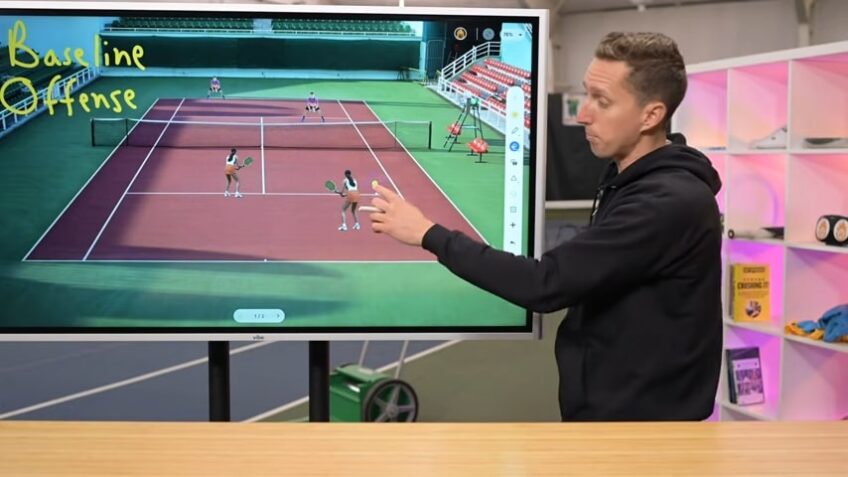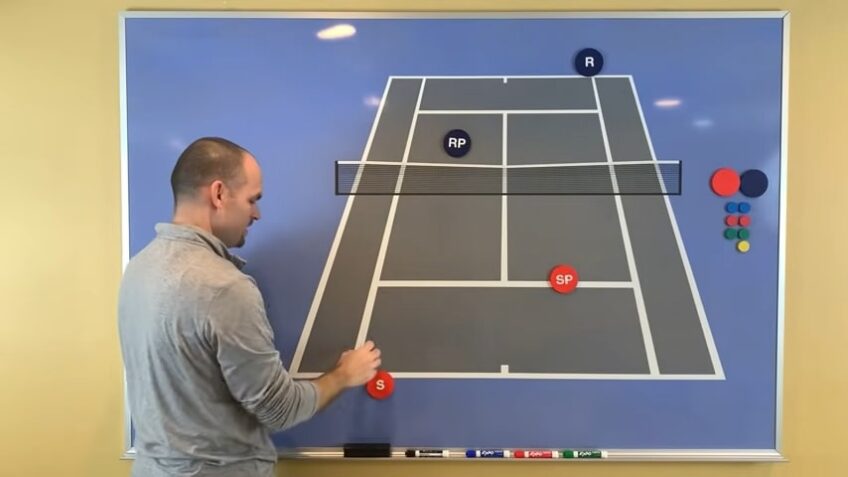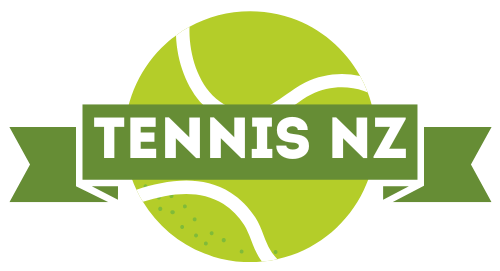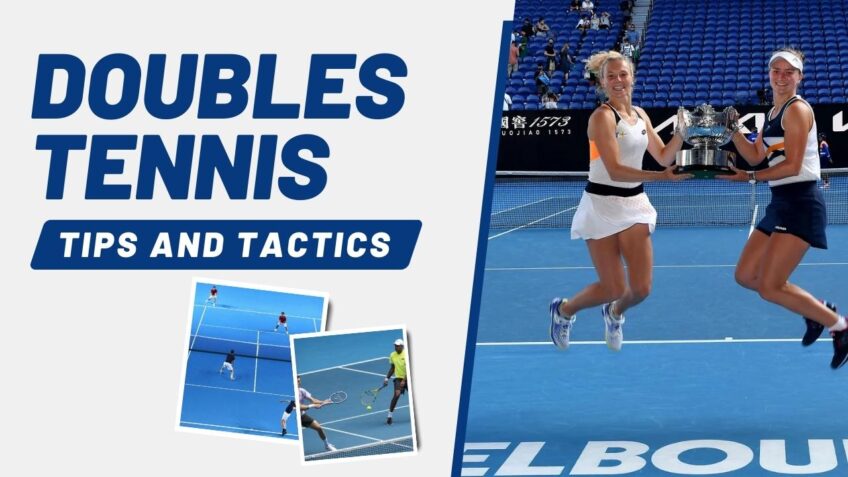Doubles tennis, a dynamic and strategic game, is an intriguing dance of power, positioning, and finesse. The game involves two teams of two players each, providing a unique blend of skill and teamwork, which distinguishes it from singles tennis.
In doubles tennis, strategy and tactics are the linchpins, in determining the flow and outcome of the game. This blog post will journey through the nuances of doubles tennis, unraveling its strategies and tactics, and exploring the essence of this fascinating sport.
The Advantages

Doubles tennis offers an enticing mix of benefits that go beyond the physical. Firstly, it’s a brilliant social activity, fostering a sense of camaraderie and teamwork. The shared responsibility and collective celebration of triumphs make it an enjoyable experience. Secondly, it can be less physically demanding than singles tennis due to the smaller area of coverage per player. This aspect makes it an excellent choice for players of all ages and fitness levels.
Additionally, doubles tennis encourages strategic thinking. Since two minds are better than one, players can use diverse strategies and varying skill sets to outmaneuver their opponents. It’s this intellectual dimension of the game that often hooks players, sparking a lifelong passion for doubles tennis.
Communication and Teamwork
Communication and teamwork are the heart and soul of doubles tennis. In this game, two individuals must move and act as one, and to do so, effective communication is vital. Players communicate verbally and non-verbally, sharing strategies, encouraging each other, and signaling upcoming plays. The best doubles teams have mastered this art of communication, creating a seamless blend of skills and strategies.
Teamwork, on the other hand, involves understanding your partner’s strengths and weaknesses, complementing their skills, and supporting them during challenging moments. It’s about being there to back up your partner when they’re drawn out of position or when they’ve committed to a particular shot. Cultivating this sense of unity and cooperation can be the difference between victory and defeat.
Court Positioning
Court positioning in doubles tennis is a strategic element that can dramatically influence the game’s outcome. It’s not just about where you are but also where your partner and opponents are. Proper positioning enables you to cover the court effectively, apply pressure on your opponents, and create opportunities for offensive play.
There are two common formations in doubles tennis: the classic formation (both players start from the baseline) and the “Up-and-Back” formation (one player starts at the net while the other starts at the baseline). Each formation has its own advantages and should be employed based on your team’s strategy and your opponents’ playing style.
Serving Strategies
The serve, being the first stroke at a point, sets the tone for the rest of the play. In doubles tennis, the server aims to start the point on a positive note by setting up their partner at the net or forcing a weak return from the opponents. A well-placed serve to the weaker side of the receiver or targeting their weaker stroke (forehand or backhand) can give your team an immediate advantage.
Strategically, the server’s partner often positions themselves at the net to intercept any weak returns and to apply pressure on the receiver. The goal is to seize control of the point from the very beginning, using the serve as a launching pad.
Return of Serve Tactics
Returning serve in doubles tennis requires anticipation, precision, and strategy. The goal is to neutralize the server’s advantage and wrestle control of the point. A good return strategy involves targeting the area away from the net player, often aiming down the line or crosscourt.
It’s also important to mix up your returns, keeping the opponents guessing. By varying the pace, direction, and depth of your returns, you can disrupt the opponents’ rhythm and prevent them from setting up an aggressive play.
The receiver’s partner plays a crucial role too, ready to poach (intercept) a weak serve or cover the court should the opponents attempt to attack the return.
Net Play Tactics
Mastering net play in doubles tennis is a game-changer. It’s the realm of quick reflexes, sharp volleys, and tactical poaching. Net dominance often translates to point dominance, as the team controlling the net can effectively cut off angles, force opponents into defensive positions, and execute winning shots.
However, successful net play requires excellent communication and coordination between partners. For instance, when one player decides to poach, the other must immediately cover the open space left behind. Similarly, both players need to maintain an appropriate distance from each other to cover the court effectively without obstructing each other’s shots.
Defensive Tactics
Defense in doubles tennis is about weathering the storm and turning the tables. The key is to stay resilient, maintain good court positioning, and use effective shot selection to neutralize your opponents’ attacks. Lobbing, for example, can be an effective defensive tactic. A well-executed lob can push the opponents back, disrupt their net dominance, and buy you time to regain a favorable court position.
In terms of court coverage, the “two back” formation (both players at the baseline) can be a solid defensive setup, especially against hard-hitting opponents. It allows for maximum court coverage and the ability to return powerful groundstrokes and overheads.
Offensive Tactics
Offense in doubles tennis is about seizing control and keeping your opponents on the back foot. It involves aggressive serving and returning, assertive net play, and exploiting the opponent’s weaknesses. The goal is to dictate the pace and direction of the game, forcing the opponents into defensive positions.
One potent offensive tactic is the “serve-and-volley,” where the server rushes to the net immediately after serving. This tactic puts pressure on the receiver and can set up a volley kill for the server. Similarly, the “chip-and-charge” tactic, where the receiver slices their return and follows it to the net, can disrupt the server’s rhythm and seize the net dominance.
Additionally, smart targeting can amplify your offensive impact. This might involve consistently hitting an opponent’s weaker side, playing between the opponents to induce confusion, or exploiting gaps in their court coverage.
Strategies for Playing Against Different Types of Opponents in Doubles Tennis

Every opponent presents a unique challenge and requires a tailored strategy. For instance, against a team that excels at net play, good defensive lobs, and passing shots can be effective. On the other hand, against baseline-dominant players, taking control of the net and forcing them to hit difficult low volleys can work well.
Similarly, if one opponent is significantly stronger than the other, a common strategy is to direct most of the play toward the weaker player. However, don’t become too predictable; occasional shots to the stronger player can keep them off-guard and prevent them from poaching.
Mental Game
Lastly, doubles tennis is as much a mental game as it is a physical one. Mental toughness involves maintaining focus, staying positive, managing nerves, and demonstrating resilience under pressure. A strong mental game can often tip the balance in tightly contested matches.
In doubles, this mental aspect extends to supporting your partner too. Encouraging words and positive body language can keep your partner’s spirits high, while effective on-court communication can ensure you stay on the same strategic page throughout the match.
Moreover, it’s crucial to stay adaptable. Being able to adjust your tactics based on the evolving dynamics of the match shows mental flexibility and can catch your opponents off guard.
FAQs
How can we support our partner in doubles tennis?
Supporting your partner in the match involves effective on-court communication, encouraging words, and positive body language. It’s about understanding each other’s game, complementing their skills, and backing them up during challenging moments.
What’s the benefit of playing doubles tennis?
It is a social activity that encourages teamwork and strategic thinking. It can be less physically demanding than singles tennis due to the smaller area of coverage per player, making it an excellent choice for players of all ages and fitness levels.
How can we improve our doubles tennis game?
Improving your doubles tennis game involves mastering effective communication, understanding court positioning, honing serving and returning skills, and developing robust net, defensive, and offensive tactics. It also requires mental toughness and the ability to adapt strategies against different types of opponents.
What is the “serve-and-volley” tactic?
The “serve-and-volley” tactic involves the server rushing to the net immediately after serving. This puts pressure on the receiver and can set up a volley kill for the server, enabling the serving team to seize control of the point.
What is the “chip-and-charge” tactic?
The “chip-and-charge” tactic involves the receiver slicing their return and following it to the net. This can disrupt the server’s rhythm and seize the net dominance, giving the receiving team an offensive edge.
What is the “two back” formation?
The “two back” formation is a defensive setup in doubles tennis where both players start at the baseline. This formation allows for maximum court coverage and is particularly effective against hard-hitting opponents. It enables the team to return powerful groundstrokes and overheads effectively.
Conclusion
The allure of doubles tennis lies in its intricate blend of physical skill, strategic thinking, and teamwork. While this blog post has unraveled the various strategies and tactics that underpin this fascinating game, the real magic happens when you step on the court and put these theories into practice.
Remember, the best doubles teams are not merely two good players; they are a cohesive unit that communicates effectively, understands each other’s game, and employs smart strategies to outwit their opponents. So, grab a partner, hit the court, and start weaving these doubles tennis strategies and tactics into your game. Your journey toward doubles mastery has just begun. May your love for this sport continue to ace every serve, volley every challenge, and enjoy every game, set, and match!

